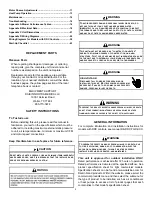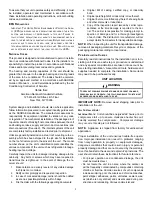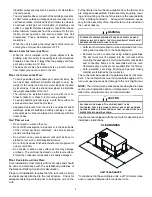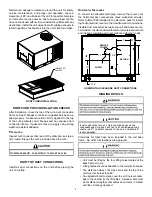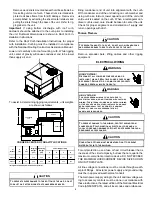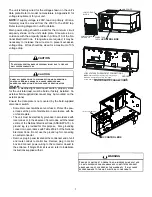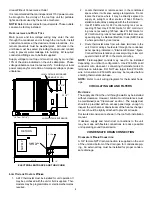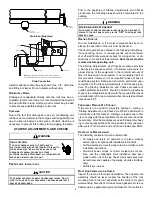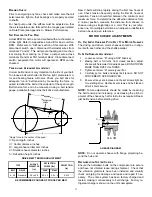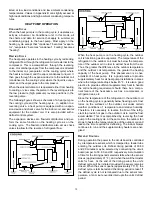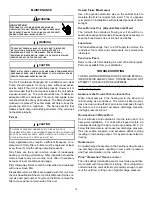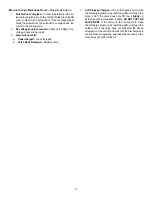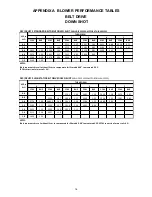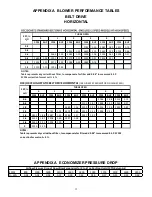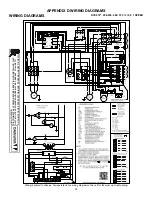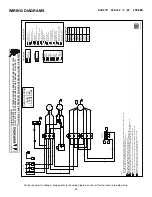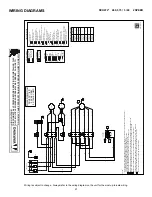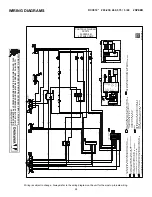
13
listed at low load conditions and low ambient condensing
temperatures. Values in Appendix B can slightly exceed at
high load conditions and high ambient condensing tempera-
tures.
HEAT PUMP OPERATION
C
OOling
C
yCle
When the heat pump is in the cooling cycle, it operates ex-
actly as a Summer Air Conditioner unit. In this mode, all
the charts and data for service that apply to summer air
conditioning apply to the heat pump. Most apply on the
heating cycle except that “condenser” becomes “evapora-
tor”, “evaporator” becomes “condenser”, “cooling” becomes
“heating”.
h
eating
C
yCle
The heat pump operates in the heating cycle by redirecting
refrigerant flow through the refrigerant circuit external to the
compressor. This is accomplished through the reversing
valve. Hot discharge vapor from the compressor is directed
to the indoor coil (evaporator on the cooling cycle) where
the heat is removed, and the vapor condenses to liquid. It
then goes through the expansion device to the outdoor coil
(condenser on the cooling cycle) where the liquid is evapo-
rated, and the vapor goes to the compressor.
When the solenoid valve coil is operated either from heating
to cooling or vice versa, the piston in the reversing valve to
the low pressure (high pressure) reverse positions in the
reversing valve.
The following figures show a schematic of a heat pump on
the cooling cycle and the heating cycle. In addition to a
reversing valve, a heat pump is equipped with an expan-
sion device and check valve for the indoor coil, and similar
equipment for the outdoor coil. It is also provided with a
defrost control system.
The expansion devices are flowrator distributors and per
-
form the same function on the heating cycle as on the
cooling cycle. The flowrator distributors also act as check
valves to allow for the reverse of refrigerant flow.
When the heat pump is on the heating cycle, the outdoor
coil is functioning as an evaporator. The temperature of the
refrigerant in the outdoor coil must be below the tempera-
ture of the outdoor air in order to extract heat from the air.
Thus, the greater the difference in the outdoor temperature
and the outdoor coil temperature, the greater the heating
capacity of the heat pump. This phenomenon is a char-
acteristic of a heat pump. It is a good practice to provide
supplementary heat for all heat pump installations in areas
where the temperature drops below 45° F. It is also a good
practice to provide sufficient supplementary heat to handle
the entire heating requirement should there be a compo-
nent failure of the heat pump, such as a compressor, or
refrigerant leak, etc.
Since the temperature of the refrigerant in the outdoor coil
on the heating cycle is generally below freezing point, frost
forms on the surfaces of the outdoor coil under certain
weather conditions of temperature and relative humidity.
Therefore, it is necessary to reverse the flow of the refrig
-
erant to provide hot gas in the outdoor coil to melt the frost
accumulation. This is accomplished by reversing the heat
pump to the cooling cycle. At the same time, the outdoor fan
stops to hasten the temperature rise of the outdoor coil and
lessen the time required for defrosting. The indoor blower
continues to run and the supplementary heaters are ener-
gized.
d
efrOst
C
OntrOl
During operation the power to the circuit board is controlled
by a temperature sensor, which is clamped to a feeder tube
entering the outdoor coil. Defrost timing periods of 30,60
and 90 minutes may be selected by connecting the circuit
board jumper to 30, 60 and 90 respectively. Accumulation
of time for the timing period selected starts when the sensor
closes (approximately 31° F), and when the wall thermostat
calls for heat. At the end of the timing period, the unit’s
defrost cycle will be initiated provided the sensor remains
closed. When the sensor opens (approximately 75° F), the
defrost cycle is terminated and the timing period is reset. If
the defrost cycle is not terminated due to the sensor tem-
perature, a ten minute override interrupts the unit’s defrost
period.


